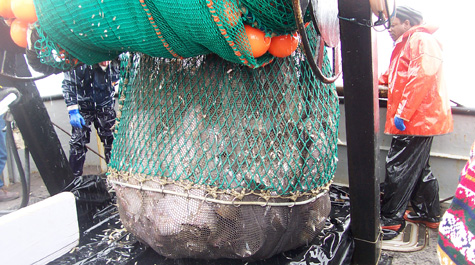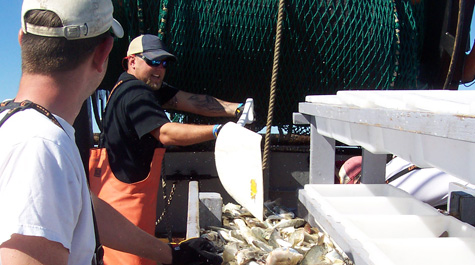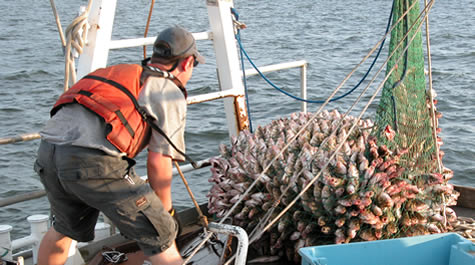VIMS fisheries team featured in children’s book
Counting the Fish in the Sea, a non-fiction book for children ages 8-12, tells the true story of how researchers from the Virginia Institute of Marine Science tackle what might seem an impossible task—figuring out just how many alewife, bluefish, croaker, and other species swim beneath the ocean waves.
 The book, by reporter and former teacher Carolyn Miller, depicts a day-in-the-life of VIMS Multispecies Survey Leader Jim Gartland and his team of scientists aboard the fishing vessel Darana R. Each page is laden with action-packed photographs depicting the most exciting moments of a research cruise, from boarding the boat in Cape May, New Jersey, to spending the day gathering and literally counting fish.
The book, by reporter and former teacher Carolyn Miller, depicts a day-in-the-life of VIMS Multispecies Survey Leader Jim Gartland and his team of scientists aboard the fishing vessel Darana R. Each page is laden with action-packed photographs depicting the most exciting moments of a research cruise, from boarding the boat in Cape May, New Jersey, to spending the day gathering and literally counting fish.
Gartland and his team—VIMS scientists Stephanie Dukes, Jameson Gregg, David Lange, and Evan McOmber—operate as part of the Northeast Atlantic Monitoring and Assessment Program (NEAMAP). They participate each year in an autumn and a spring cruise, with the goal to collect fisheries-independent data between Martha’s Vineyard and Cape Hatteras. Unlike fisheries-dependent data, which embody non-biological factors like fishing effort and market price, fisheries-independent data are collected using random sampling and other scientific techniques to ensure that they can be used to accurately estimate a fish stock, rather than the number that are harvested.
Gartland has served as team leader on NEAMAP’s Mid-Atlantic/Southern New England Nearshore Trawl Survey since its start in 2006. He does so under the auspices of NEAMAP’s lead scientists, VIMS Professor Rob Latour and Fisheries Data Analyst Chris Bonzek.
Gartland and Miller met during a NEAMAP demonstration tow in 2008. Miller—a writer for the Cape May County Herald in New Jersey—immediately thought the story of the scientists and their program at sea would make a great subject for a children’s book.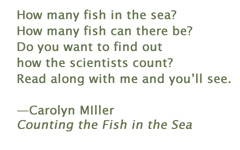
A former teacher, Miller says her students were always interested in ecology and environmental issues, especially living in such proximity to the ocean. “Children are not strangers to the sea, but they don’t really understand what’s going on beneath it,” she says. “They know the excitement that comes with catching a fish, but it’s important for them to know there are rules and regulations to keep the sea healthy and the fisheries well-managed and secure for generations to come.”
“A lot of kids go to the beach for vacations and class trips, and this book gives them an idea of some of the common species inhabiting local waters,” adds Gartland. “Whenever you go fishing, you have a chance to see something new and learn something about marine life. Carolyn did a great job of capturing that in this book.”
In addition to the book, Miller developed a way for children to continue learning about life under the sea by creating a website and an interactive blog following the adventures of Sandy the Flounder. Kids are able to visit the site to ask questions they have about the book or marine fishes, with Carolyn right there to answer their questions.
Gartland hopes the book will inspire scientific aspirations in its readers. “I’ve known I wanted to be a fisheries scientist since I was 11-years old,” he says. “One day, I was flounder fishing with my dad off the coast of New Jersey, when the NMFS trawl survey vessel Albatross pulled up next to us and made a survey tow. Right then and there I decided that was what I wanted to do when I grew up, and 25 years later I’m doing it. Maybe this book can serve as a similar career inspiration for young kids.”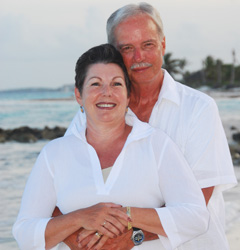
Since NEAMAP’s inception in 2006, program scientists have used trawl surveys to collect and count more than 7.5 million fish, most of which are released back into the water (a small number are kept for diet and aging studies). The information gathered from each survey is shared with federal and state agencies to help them regulate commercial and recreational fisheries and help fishers understand what’s happening in the sea.
Survey results are used by the Atlantic States Marine Fisheries Commission (ASMFC), the Mid Atlantic Fisheries Management Council (MAFMC), the New England Fisheries Management Council (NEFMC), and the Northeast Fisheries Science Center (NEFSC).
The book can be purchased in the VIMS Gift Shop.


